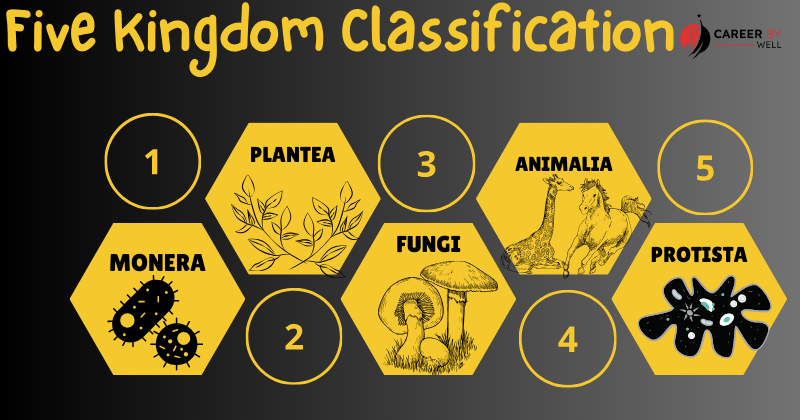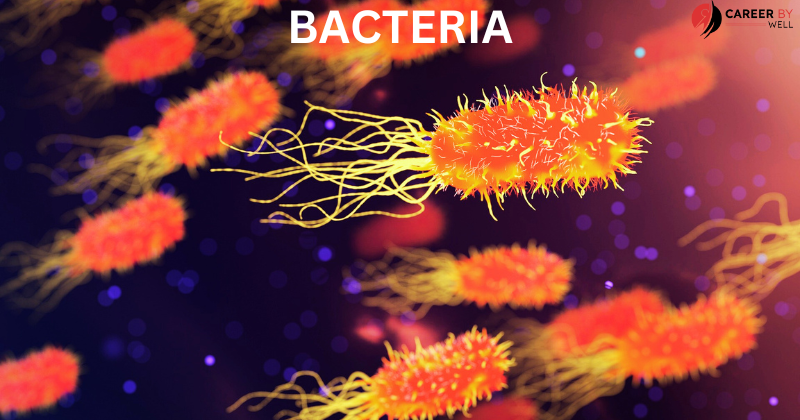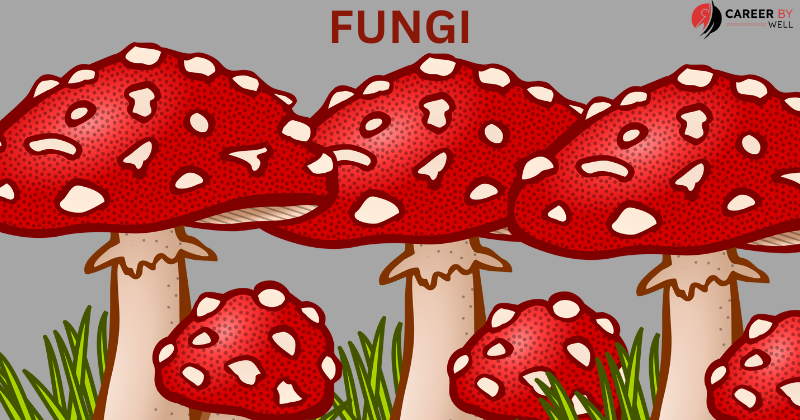The Five Kingdom Classifications of living organisms, by Robert H. Whittaker in 1969, was based on several main principles to categorize.
The Five Kingdom Classifications of living organisms is an older system based on their fundamental characteristics. This classification system was proposed by American biologist Robert H. Whittaker in 1969.
While it has been largely replaced by more modern and detailed classifications of living organism systems. Besides. It provides a historical perspective on how scientists once categorized life on Earth.
What is Microorganism?
Microorganisms, often referred to as microbes, are tiny living organisms. These are too small to be seen with the naked eye. They encompass vast and diverse life forms belonging to different life domains.
Principle Of Kingdom Classifications of Living Organisms
The Five Kingdom Classifications of living organisms system, proposed by Robert H. Whittaker in 1969, was based on several main principles to categorize and classify living organisms into five distinct kingdoms.
These principles aim to group organisms based on fundamental characteristics and evolutionary relationships. There were five principles for these classifications of living organisms.
These principles are:
- Cell Structure
- Nutrition
- Cell Wall Composition
- Mobility
- Other Characteristics
Here is a detailed overview of all these principles of the kingdom classifications of living organisms:
1. Cell Structure:
One of the primary criteria for kingdom classification of living organisms was the cellular structure of organisms.
Here organisms were classified as prokaryotes or eukaryotes based on the presence or absence of a true nucleus and membrane-bound organelles.
Prokaryotes are a group of microorganisms characterized by the absence of a true nucleus and other membrane-bound organelles in their cells.
Eukaryotes are a group of organisms characterized by having cells with a true nucleus and other membrane-bound organelles.
Prokaryotes (organisms lacking a true nucleus) were placed in the Monera kingdom, which included bacteria and archaea.
While Eukaryotes (organisms with a true nucleus) were further divided into the remaining four kingdoms.
2. Nutrition:
Further, the mode of nutrition was another crucial factor in the kingdom classifications of living organisms. Organisms were categorized into two groups based on their nutritional strategies.
- Autotrophic or
- Heterotrophic
Generally, Autotrophic organisms were those capable of producing their food through processes like photosynthesis, and they were placed in the Plantae kingdom.
Besides Heterotrophic organisms, which relied on external organic compounds for nutrition.
3. Cell Wall Composition:
Next, the composition of the cell wall also played a role in classification. Organisms with cell walls made of cellulose were placed in the Plantae kingdom (plants).
While Organisms with cell walls made of chitin were placed in the Fungi kingdom (fungi).
4. Mobility:
Then the presence or absence of mobility was considered in classification.
Organisms capable of movement, such as animals and some protists, were placed in the Animalia and Protista kingdoms. While immobile organisms, like plants and fungi, were classified into the Plantae and Fungi kingdoms, respectively.
5. Other Characteristics:
Additional characteristics and evolutionary relationships were considered to refine classification within each kingdom.
For example, the Protista kingdom included various unicellular eukaryotes with diverse characteristics and nutritional strategies. While the Animalia kingdom comprised multicellular, heterotrophic organisms with specialized tissues and organ systems.
Undoubtedly, the Five Kingdoms Classification was a significant step in organizing the diversity of life on Earth. It has since been largely replaced by more detailed and phylogenetically-based classification systems.
Further, modern molecular techniques have allowed scientists to better understand the evolutionary relationships among organisms, leading to more accurate and comprehensive classification systems.
Nevertheless, the Five Kingdoms Classifications of microorganisms remain an important historical milestone in biology.
Classifications Of Microorganisms
However, Microorganisms are classified into several major categories based on their characteristics, cellular structures, and genetic makeup.
There are five kingdom classifications of microorganisms. These classifications are under.
- Monera (Bacteria and Archaea)
- Protista
- Fungi
- Plantae
- Animalia
1. Monera (Bacteria and Archea)
Features of Monera
Prokaryotic Cells:
Usually, all organisms in the Monera kingdom have prokaryotic cells. This means they lack a true nucleus, and their genetic material (typically a single circular DNA molecule) is not enclosed within a membrane-bound nucleus.
Single-Celled:
Monera organisms are primarily unicellular, although they can form colonies of cells. They do not have complex, multicellular structures like plants and animals.
Absence of Membrane-
Bound Organelles: Monera cells lack membrane-bound organelles such as mitochondria, endoplasmic reticulum, and Golgi apparatus, which are commonly found in eukaryotic cells.
Cell Wall:
Most Monera have a cell wall, which provides structural support and protection. The composition of the cell wall can vary, with bacteria typically having peptidoglycan in their cell walls, while archaea have different compositions.
Diverse Shapes and Sizes:
Monera exhibits a wide range of shapes, including spherical (cocci), rod-shaped (bacilli), spiral (spirilla), and other forms. They also vary in size, from microscopic to visible under a light microscope.
Nutritional Diversity:
Monera organisms display diverse nutritional strategies. Some are autotrophic, capable of photosynthesis or chemosynthesis to produce their own food. Others are heterotrophic, obtaining nutrients from organic or inorganic sources. Some are saprophytic, feeding on decaying matter, while others are parasitic or symbiotic.
Reproduction:
Usually, monera reproduce asexually through binary fission, where one cell divides into two identical daughter cells. Some bacteria can also exchange genetic material through horizontal gene transfer methods like conjugation.
Habitat Diversity:
Monera is found in many environments, including terrestrial (soil), aquatic (freshwater and marine), extreme habitats like hot springs, acidic lakes, and deep-sea hydrothermal vents. Some are also associated with other organisms as commensals, mutualists, or pathogens.
Role in Ecosystems:
Monera play essential roles in ecosystems. They are involved in processes such as decomposition, nitrogen fixation (converting atmospheric nitrogen into a usable form), and cycling of nutrients. Some are crucial in bioremediation, breaking down pollutants in the environment.
Pathogenic Species:
While many Monera are harmless or beneficial, some are pathogenic and can cause plant, animal, and human diseases. Examples include various disease-causing bacteria.
Kingdom monera can be classified into three types:
- Eubacteria
- Archaebacteria
- Cyanobacteria
2. Protista:
The classification of Protista is somewhat complex due to the diverse nature of organisms within this kingdom.
Protista is a kingdom of eukaryotic microorganisms that don’t fit neatly into other established kingdoms like Plantae, Animalia, or Fungi.
Instead, Protista serves as a catch-all category for various unicellular, colonial, or simple multicellular eukaryotes.
Features of Protista
Eukaryotic Cells:
Protists have eukaryotic cells, which means they possess a true nucleus enclosed within a membrane, along with other membrane-bound organelles such as mitochondria, Golgi apparatus, and endoplasmic reticulum.
Unicellular or Simple Multicellular:
Protists can be unicellular, existing as single cells with specialized organelles. Some may form simple multicellular colonies, where individual cells work together but are not highly specialized.
Diverse Nutritional Strategies:
Protists exhibit a wide range of nutritional strategies. Some are autotrophic and capable of photosynthesis to produce their food (algae).
Moreover, others are heterotrophic, relying on organic material from their environment for nutrition. Some can switch between autotrophic and heterotrophic modes.
Habitat Diversity:
Protists are found in various habitats, primarily aquatic environments such as freshwater and marine ecosystems. They can also inhabit moist terrestrial environments, soil, and even the internal environments of other organisms as parasites or symbionts.
Reproduction:
Protists can reproduce both sexually and asexually. Reproduction methods vary widely among different groups of protists. Some reproduce by binary fission, others by conjugation or sporulation.
Diversity in Cellular Structure:
Protists display a wide variety of cell shapes and structures. For example, some have flagella or cilia for movement, while others use pseudopods (temporary, bulging cell membrane extensions) to move.
Ecological Roles:
Protists play important roles in ecosystems. Photosynthetic protists are primary producers, forming the base of aquatic food chains.
Further, others serve as prey for larger organisms. Some protists form symbiotic relationships with other organisms, while parasitic protists can cause diseases in plants, animals, and humans.
Lack of Tissues and Organs:
Protists typically lack specialised tissues and organs, unlike more complex multicellular organisms like animals and plants.
However, some colonial protists may exhibit limited cell differentiation.
Phylogenetic Diversity:
Protists are not a monophyletic group, meaning they do not share a common evolutionary ancestor.
Instead, the kingdom Protista is a “catch-all” category for eukaryotic organisms that do not fit into other kingdoms.
Kingdom protista can be classified into five groups such as:
- Chrysophytes
- Dinoflagellates
- Euglenoids
- Slime Moulds
- Protozoans
3. Fungi:
Fungi are a diverse group of eukaryotic microorganisms that play important roles in ecosystems and have various practical application
Features Of Fungi
Eukaryotic Cells:
Usually, these are composed of eukaryotic cells, which means they have a true nucleus enclosed within a membrane, along with other membrane-bound organelles like mitochondria and Golgi apparatus.
Cell Wall Composition:
Indeed they have a unique cell wall made primarily of a complex sugar called chitin, which provides structural support and protection.
Heterotrophic Nutrition:
Fungi are heterotrophic organisms, meaning they obtain nutrients by absorbing organic material from their environment. They are decomposers, breaking down complex organic compounds into simpler substances.
Absorption of Nutrients:
Fungi secrete enzymes that break down organic matter externally. Once the organic material is broken down into simpler molecules, fungi absorb these nutrients directly through their cell walls.
Reproduction:
Fungi can reproduce both sexually and asexually. Asexual reproduction often involves the formation of spores, while sexual reproduction involves the fusion of specialized sexual structures, resulting in genetic diversity.
Growth Forms:
Fungi exhibit diverse growth forms. They can be unicellular (yeasts), multicellular (moulds), or form complex, often branching structures called mycelium. Mycelium is composed of thread-like structures called hyphae.
Ecological Roles:
Fungi are crucial for nutrient cycling and decomposition in ecosystems. They break down dead organic matter, such as fallen leaves and wood, returning essential nutrients to the environment.
Symbiotic Relationships:
Fungi can form beneficial symbiotic relationships with other organisms. Mycorrhizal fungi, for example, form partnerships with plant roots, aiding in nutrient uptake.
Lichens are another example of a symbiotic association between fungi and algae or cyanobacteria.
Diversity:
Fungi represent a highly diverse group, with estimates of fungal species ranging from hundreds of thousands to over a million.
They inhabit various environments, from terrestrial to aquatic, and can be found on every continent.
Medicinal and Industrial Uses:
Fungi have practical applications in biotechnology and industry. They are used in the production of antibiotics (e.g., penicillin), enzymes (e.g., in cheese production), and various fermented foods (e.g., bread and beer).
Pathogens:
Some fungi are pathogenic and can cause plant, animal, and human diseases.
Examples include Candida (causing yeast infections), Aspergillus (responsible for lung infections), and various plant pathogens causing crop diseases.
Economic Impact:
Fungi can have both positive and negative economic impacts.
Besides, beneficial fungi contribute to agriculture and biotechnology, while harmful ones can damage crops, food products, and building materials.
4. Plantae:
Plantae, often simply called plants, represent one of the five major kingdom classifications of living organisms.
Moreover, plants are multicellular eukaryotic organisms with many species and characteristics.
Features Of Plantae
Eukaryotic Cells:
Plants are composed of eukaryotic cells, which means they have a true nucleus enclosed within a membrane, along with other membrane-bound organelles like mitochondria and chloroplasts.
Autotrophic Nutrition:
Plants are autotrophic, meaning they are capable of photosynthesis. They use chlorophyll and other pigments to capture light energy and convert carbon dioxide and water into glucose and oxygen in sunlight.
Cell Wall:
Apart from Plant cells have a rigid cell wall made primarily of cellulose, providing structural support and protection for the cell.
Multicellularity:
Most plants are multicellular organisms with specialized cells, tissues, and organs. They exhibit complex growth patterns and life cycles.
Reproduction:
Plants can reproduce both sexually and asexually. Sexual reproduction involves the formation of seeds through the fusion of male and female gametes.
Additionally, asexual reproduction can occur through runners, bulbs, and cuttings.
Alternation of Generations:
Plants typically exhibit an alternation of generation’s life cycle, involving haploid (gametophyte) and diploid (sporophyte) stages. Indeed this cycle includes the production of spores and gametes.
Habitats:
Plants can be found in various terrestrial and aquatic environments, from deserts to rainforests, freshwater lakes, and deep ocean floor (seagrasses).
Further, they are primary producers in ecosystems, forming the base of the food chain.
Diversity:
Plants encompass an incredible diversity of species, ranging from tiny mosses and algae to towering trees. This diversity includes various growth forms, such as herbaceous plants, shrubs, and woody trees.
Symbiotic Relationships:
Plants can form beneficial symbiotic relationships with mycorrhizal fungi, which assist in nutrient uptake, and nitrogen-fixing bacteria, which enhance nitrogen availability in the soil.
Medicinal and Industrial Uses:
Many plants have medicinal properties and are used in traditional and modern medicine.
Additionally, they provide resources for various industries, such as timber for construction and paper production.
Economic Importance:
Plants are essential for agriculture, providing food crops (e.g., wheat, rice, maize), cash crops (e.g., cotton, coffee, rubber), and ornamental plants (e.g., flowers, ornamental trees).
Environmental Impact:
Plants play a crucial role in maintaining the Earth’s atmosphere by absorbing carbon dioxide and releasing oxygen through photosynthesis.
They also help prevent soil erosion and contribute to climate regulation.
5. Animalia:
Animalia, often called the animal kingdom, represents one of the five major kingdoms classifications of living organisms.
Moreover, animals are multicellular, eukaryotic organisms that display a wide range of characteristics and adaptations.
Features of Animalia
Eukaryotic Cells:
Animals comprise eukaryotic cells, meaning they have a true nucleus enclosed within a membrane and other membrane-bound organelles like mitochondria and Golgi apparatus.
Heterotrophic Nutrition:
Animals are heterotrophic organisms, which means they obtain their nutrition by consuming other organisms or organic matter. They are unable to perform photosynthesis or chemosynthesis.
Multicellularity:
All animals are multicellular, meaning they consist of multiple specialized cells that work together to perform various functions within the organism.
Tissues and Organs:
Animals have tissues that are organized into organs, forming organ systems. These systems perform specific functions like digestion, circulation, and respiration.
Motility:
Most animals are capable of movement at some point in their life cycle. Besides, this mobility can range from simple locomotion to complex behaviours.
Sensory Organs:
Animals possess sensory organs like eyes, ears, and tactile structures that allow them to perceive and respond to their environment.
They can detect stimuli such as light, sound, touch, and chemicals.
Reproduction:
Animals reproduce both sexually and, in some cases, asexually. Sexual reproduction involves the fusion of male and female gametes to produce offspring with genetic diversity.
Embryonic Development:
Many animals go through distinct stages of embryonic development, including cleavage, gastrulation, and organogenesis. These stages can vary widely among different animal groups.
Larval Stages:
Some animals undergo metamorphosis, transitioning from larval to adult forms. This process often involves significant changes in body structure and behaviour.
Diverse Habitats:
Animals inhabit virtually every environment on Earth, from terrestrial ecosystems (land) to aquatic environments (freshwater and marine) and even aerial habitats (airborne insects).
Diversity:
Animals are incredibly diverse, with millions of species identified and many more yet to be discovered. They encompass various body forms, sizes, and ecological roles.
Ecological Roles:
Animals play crucial roles in ecosystems. They can be herbivores, carnivores, omnivores, decomposers, or pollinators, contributing to nutrient cycling and maintaining ecosystem balance.
Social Behavior:
Many animals exhibit social behaviour, living in groups or colonies with complex social structures. Examples include social insects like ants and bees and social mammals like wolves and elephants.
Cognition and Learning:
Some animals, particularly mammals and birds, display advanced cognitive abilities, including problem-solving, communication, and learning from experience.
Cultural and Economic Significance:
Animals have cultural and economic importance for humans. Further, they provide food, clothing, transportation, and pets and serve as subjects of scientific study and conservation efforts.
Final Thoughts
In short, the Five Kingdoms Classifications of living organisms were a significant step in organizing the diversity of life on Earth.
Further, it has since been replaced by more detailed and phylogenetically-based classification systems, such as the three-domain system.
This newer system recognizes three domains of life: Bacteria, Archaea, and Eukarya, which better reflect the evolutionary relationships among organisms.
However, the Five Kingdoms Classifications of living organisms remain a part of biological classification and taxonomy history.


